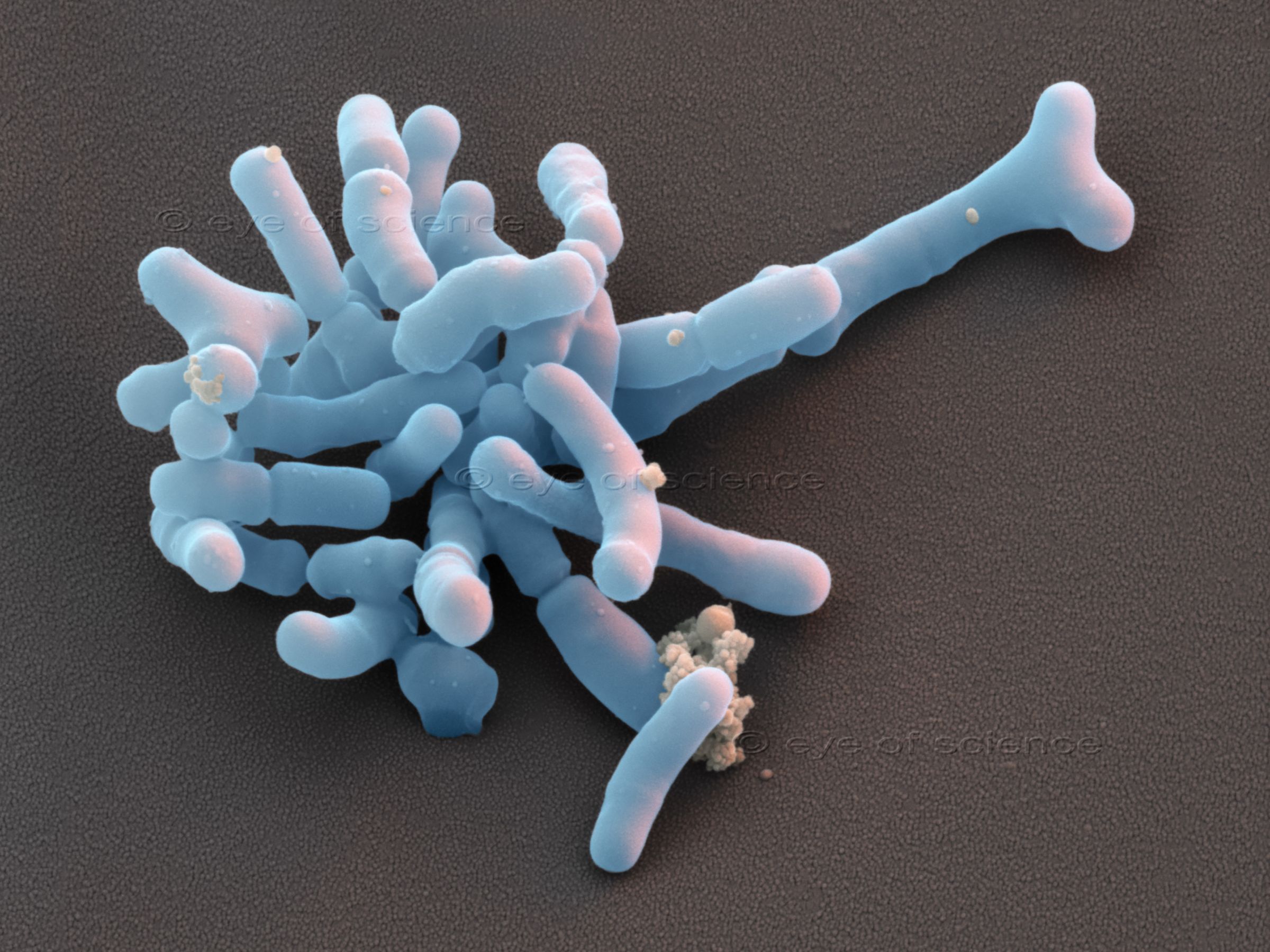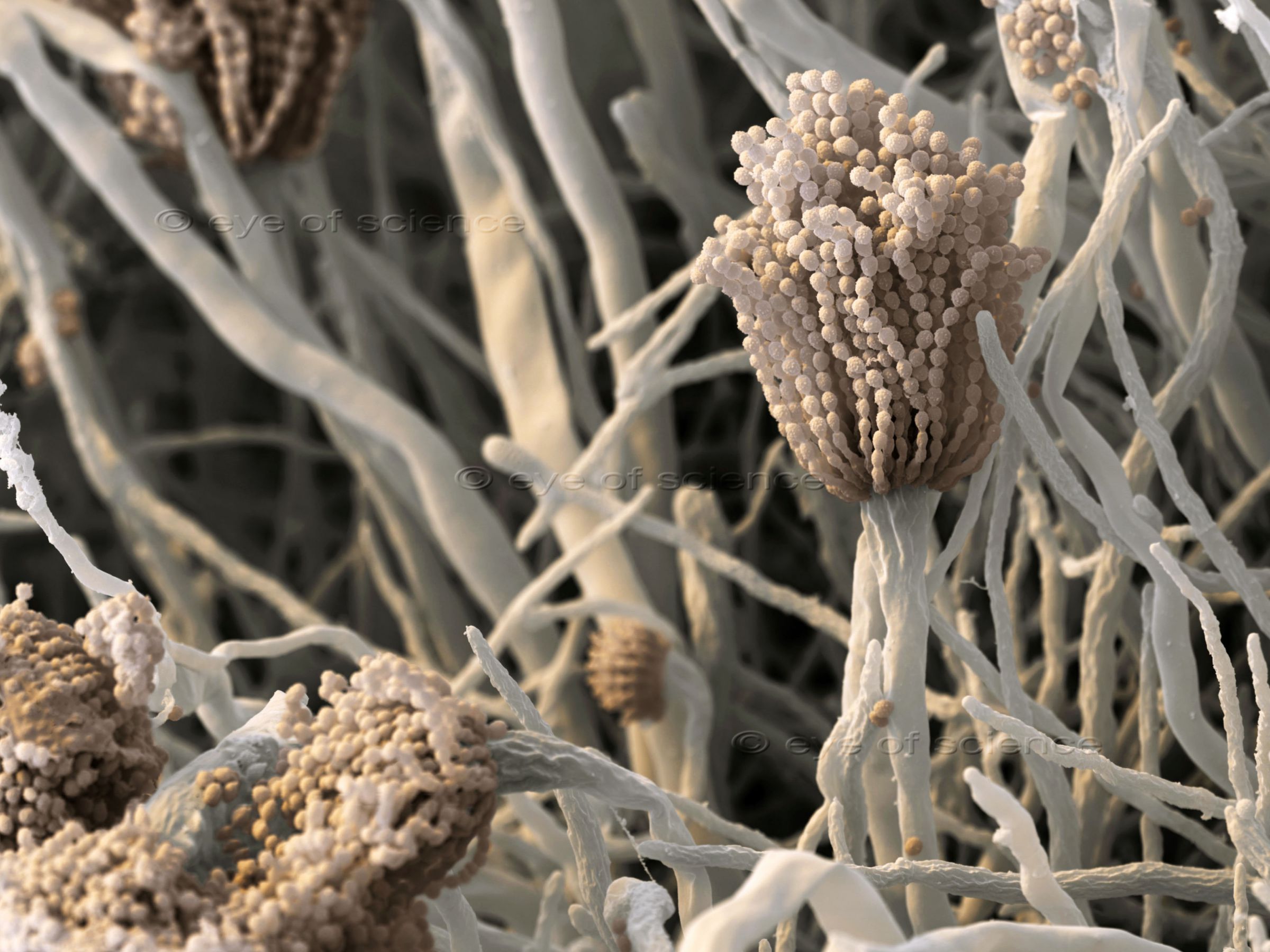
Microphotograph of a Foraminifera
Foraminifera are single cell organisms found in sea water. They build shells in various forms, mostly made of calcium carbonate. Scanning Electron Microscope, 160:1 (when 15cms wide)
Foraminiferen sind einzellige Meeresorganismen. Sie bilden eine Schale, meist aus Kalk, in sehr verschiedenen Formen. Raster-Elektronenmikroskop, 160:1 (bei 15cm Bildbreite)

Transmission electron microscope image of a Bacteriophage
Ultra thin section of a Escherichia coli bacterium infected with T-Phages. Transmission Electron Microscope, 90000:1 (when 15cms wide)
Ultradünnschnitt durch ein Escherichia coli Bakterium, das mit T-Phagen infiziert ist. Transmissions-Elektronenmikroskop, 90000:1 (bei 15cm Bildbreite)

Candida albicans
The yeast Candida albicans may cause infections of the mucosa in mouth or vagina. Scanning Electron Microscope, 820:1 (when 15cms wide)
Die Hefe Candida albicans kann Infektionen der Mund- und Vaginalschleimhaut auslösen. Raster-Elektronenmikroskop, 820:1 (bei 15cm Bildbreite)

Escherichia coli
Escherichia coli is an intestinal bacteria. It is the best discovered bacteria because it is known for about 140 years and can be easily cultivated. Transmission Electron Microscope, 21500:1 (when 15cms wide)
Escherichia coli ist ein Darmbakterium. Da es bereits im 19. Jahrhundert entdeckt wurde und leicht kultiviert werden kann, gehört es zu den best erforschten Bakterien. Transmissions-Elektronenmikroskop, 21500:1 (bei 15cm Bildbreite)

Bifidobacterium breve
The lactic acid bacteria Bifidobacterium breve is a bacteria used as "Probiotic". It may regulate digestion by building lactic acid. Scanning Electron Microscope, 27000:1 (when 15cms wide)
Bifidobacterium breve ist ein "probiotisches" Bakterium, das z.B. in Joghurt und milchsauer vergorenem Gemüse zu finden ist. Raster-Elektronenmikroskop, 27000:1 (bei 15cm Bildbreite)

Aspergillus fumigatus
Aspergillus fumigatus is a common fungus that may cause infections in immunodeficient people if the spores are inhaled. Scanning Electron Microscope, 800:1 (when 15cms wide)
Aspergillus fumigatus ist ein Gieskannenschimmel, der Infektionen bei immungeschwächten Personen auslösen kann, wenn die Sporen eingeatmet werden. Raster-Elektronenmikroskop, 800:1 (bei 15cm Bildbreite)

Bacillus anthracis
Bacillus anthracis is known as the biological weapon "Anthrax". The bacteria are able to build spores that resist heat, chemicals and drying. Transmission Electron Microscope, 10000:1 (when 15cms wide)
Bacillus anthracis ist als biologischer Kampfstoff "Anthrax" bekannt. Das Bakterium kann Sporen bilden, die gegen Hitze, Chemikalien und Austrocknung resistent sind. Transmissions-Elektronenmikroskop, 10000:1 (bei 15cm Bildbreite)

Badhamia utricularis
Hanging fruiting bodies of the slime mould Badhamia utricularis. Slime moulds are single-cell organisms with millions of cores living in forest soil. Scanning Electron Microscope, 37:1 (when 15cms wide)
Der Schleimpilz Badhamia utricularis bildet hängende Fruchtkörper auf der Unterseite von umgestürzten Bäumen. Raster-Elektronenmikroskop, 37:1 (bei 15cm Bildbreite)

Acidovorax
These Acidovorax bacteria were found on the bottom of Lake constance. They oxidate iron. Scanning Electron Microscope, 8000:1 (when 15cms wide)
Diese Acidovorax Bakterien stammen au dem Bodensee. Sie oxydieren Eisen. Raster-Elektronenmikroskop, 8000:1 (bei 15cm Bildbreite)

Aeromonas hydrophila
Aeromonas hydrophila is a bacteria common in water in warm climates. The bacteria may cause sepsis if they enter the bloodstream. Scanning Electron Microscope, 3600:1 (when 15cms wide)
Aeromonas hydrophila ist ein Bakterium, das häufig in warmen Gewässern zu finden ist. Es kann eine Sepsis auslösen, wenn es in die Blutbahn gelangt. Raster-Elektronenmikroskop, 3600:1 (bei 15cm Bildbreite)
Other topics
Andere Themenfelder
© Copyright for all images on this site by eye of science. All rights reserved.








